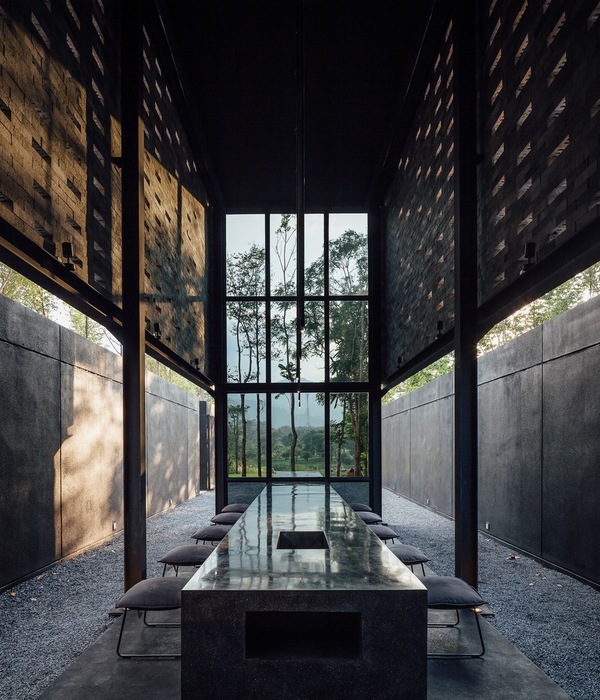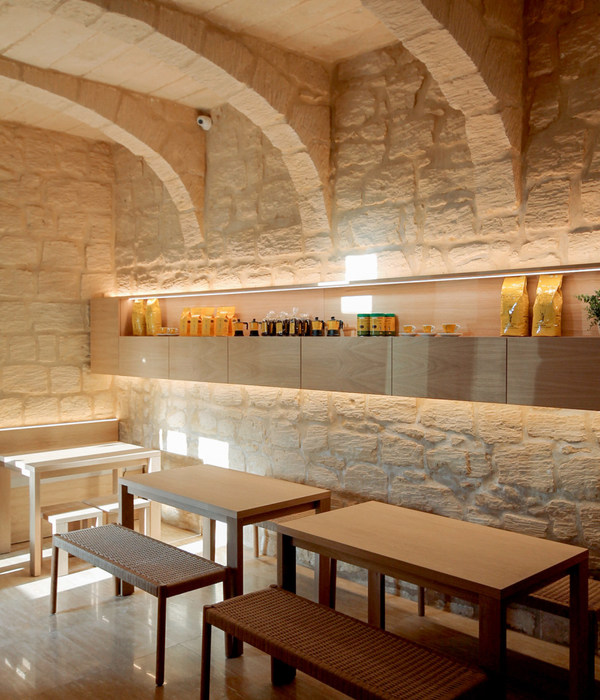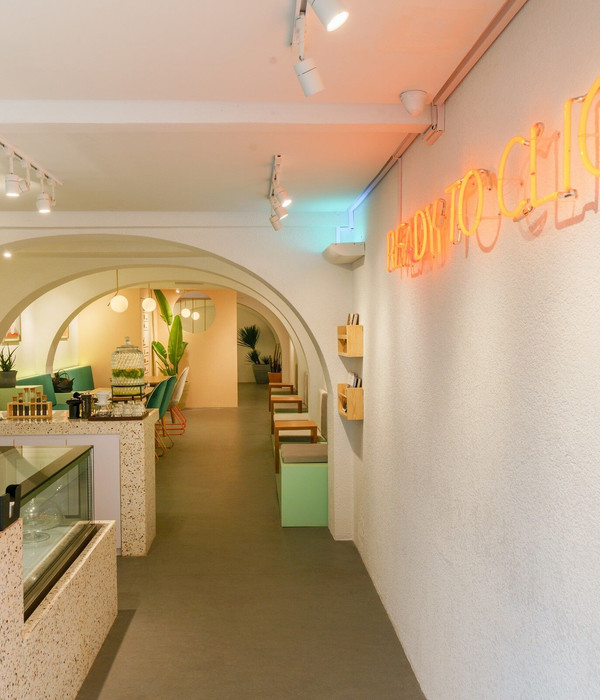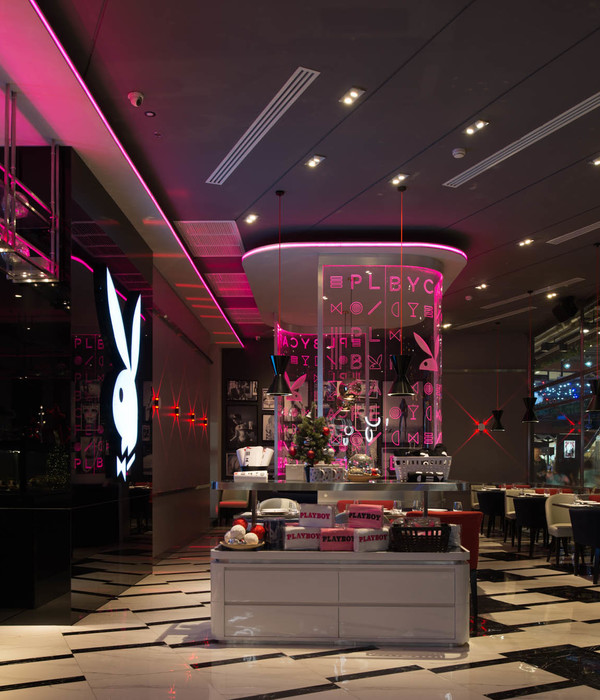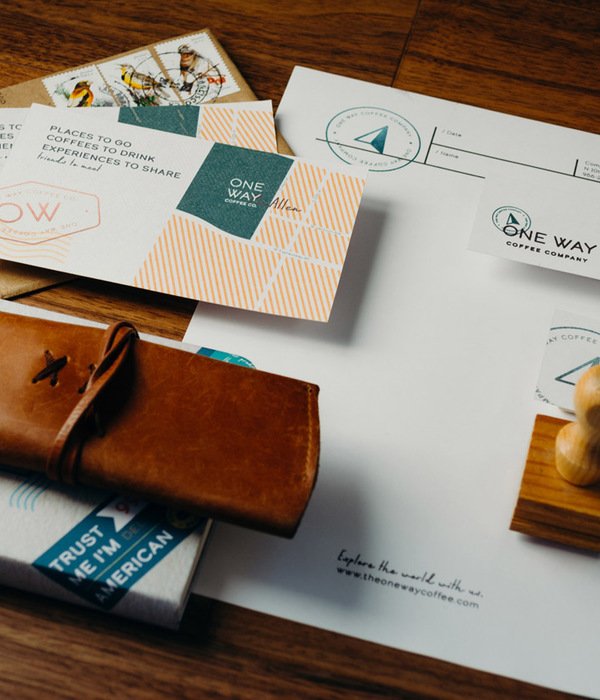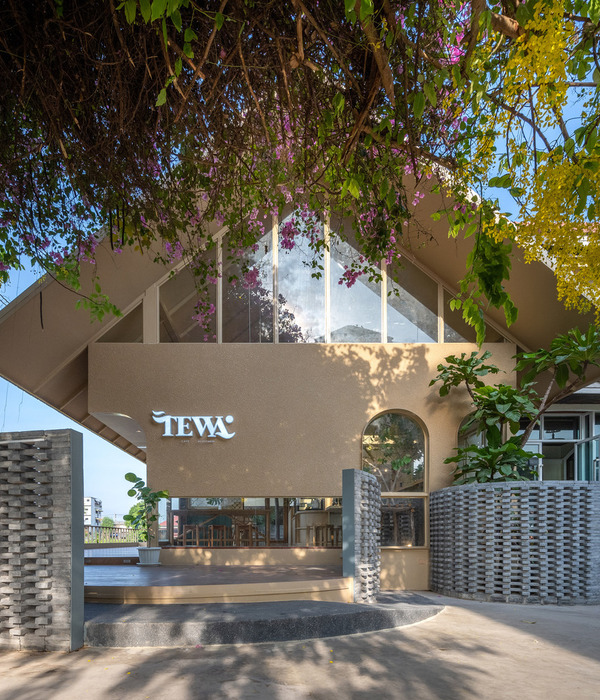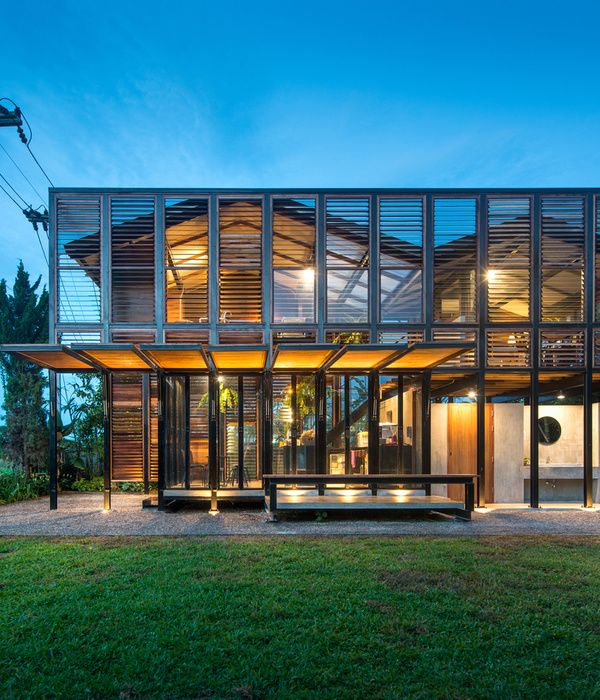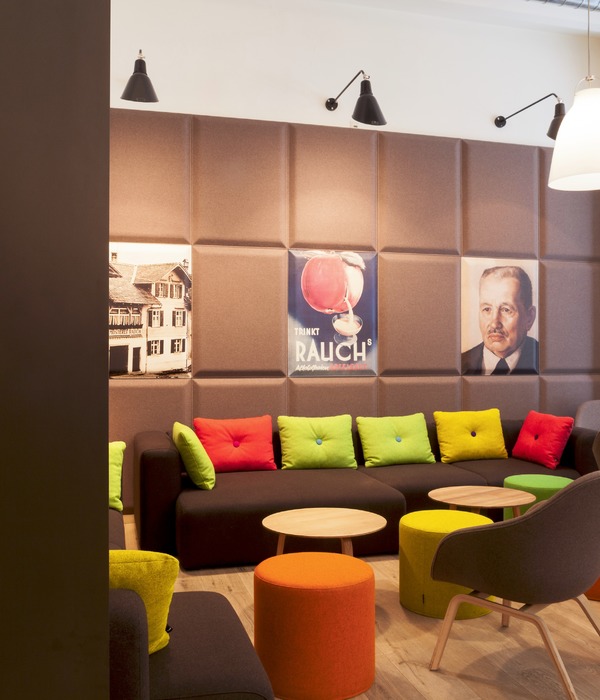- 项目名称:云间粮仓茶室——现代与历史的完美融合
- 项目类型:建筑,改造,室内
- 业主:且过亭
- 设计公司:DCDSAA淀川建筑事务所
- 主持建筑师:王皓
- 设计团队:袁郑亮,唐超,颜丙坤
- 设计时间:2020年11月
- 建成时间:2021年2月
- 主要材料:不锈钢金属,钢板,超白玻,木饰面,素水泥,肌理漆
- 项目摄影:ELTON STUDIO朱恩龙
项目位于松金公路10053号,上世纪五十年代至九十年代陆续建造起的粮食仓库及工厂,经过全新规划升级为云间粮仓文创园,该园区占地面积136亩,建筑面积近4万平方米,共59栋老建筑,园区分为万国啤酒文化区、艺术展示互动区、科技创意办公区、沿岸生活休闲区、时尚网红打卡区等区域。
The project is located at No.10053 Songjin Avenue. Grain warehouses and factories built in succession from 1950s to 1990s have been upgraded and transformed into Warehouses on Clouds Cultural and Creative Park through new planning. The park covers an area of 136 mu, with a building area of nearly 40,000 ㎡, including 59 old buildings. The park is divided into International Beer Culture Area, Art Exhibition Interactive Area, Sci-Tech Creative Office Area, Coastal Living and Leisure Area and Fashionable Online Celebrity Shooting Area, etc.
▼建筑外观,external view of the building
本案项目茶室坐落在东37栋,靠人民河岸边的一栋老建筑,云间粮仓的临河亲水岸线上,古朴沧桑,岁月留痕;沿河岸线内侧较为空旷,适宜开发水码头茶文化驿站。游人在此歇歇脚,品品茶,看看景,绝对是一种得风得水、得天地灵气的休闲享受。
The teahouse in the Plan is located in Block 37 East, an old building near the banks of the People River. On the riverside line of Warehouses on Clouds, there are many vicissitudes of life; The inner side along the riverbank line is relatively empty, which is suitable for developing tea houses on the wharf. Visitors stay here to rest, drink tea and look at the scenery, can absolutely enjoy the touch of the wind and the flow of water as well as enjoy themselves physically and mentally.
▼项目区位,location
▼改造前项目外观,original view of the project before renovation
“且过亭茶空间”项目独栋老建筑改造,遵循着本土人文新地标的原则,最大限度地保留了老建筑的历史风貌痕迹,从听、闻、品、观、悟人的五种感官去发现都包含了,风、花、茶、云、凡尘,给人一种灵性,仿佛身处世外桃源,让人有种静谧淡然的的感觉;茶空间的材料特性难以持久,且涵濡着诗意般的冲动,白色的建筑墙面,现代穿插的玻璃盒子,水平线的一字条窗,经过改造之后别有一番韵味。
“Qie Guo Pavilion (Ignorance is Bliss Pavilion) Space” , a single one of the old building reconstruction, follows the principle of the new landmark of local humanities, the historical features and traces of the old buildings have been preserved to the maximum extent, to get in touch with the wind, flowers, tea, clouds and dust from the five human senses, such as hear, smell, taste, see and understand, Bring people a kind of spiritual enjoyment, as if they were in a paradise; The material characteristics of tea space are difficult to sustain and rich in poetry. On the wall of the white building, there are modern glass boxes and horizontal note windows, which have a lasting appeal after being transformed.
▼顶视图,top view
▼项目外观,立面上设有一字条窗,external view of the project with ribbon windows on the facade
白色墙体上切开一块挑空的玻璃盒子,不仅起到阳台品茶感受的作用,而且还可以网红打卡拍照户外全景效果,每一个时间段都是非常唯美,一年四季变化融入其中;首层的品茶接待区和茶室也非常巧妙向空间延伸,户外的人民河荡漾的波纹水影画面能够反射出室内的光线及倒影。
A hollow glass box was cut on the white wall, which functions are to enjoy the fragrance of tea on the balcony, and to give a panoramic view of the outdoor scenery for online celebrity. Each time period is very beautiful and integrates with the changes of the seasons; the Tea-Tasting Reception Area and Teahouse on the 1
st
floor are also subtly extended to the depths, with the ripples and reflections of the People’s River outside reflecting the interior so as to make it brighter.
▼突出的玻璃盒子与室外平台,extruding glass box and outdoor platform
▼玻璃盒子茶室,tearoom in glass box
▼玻璃茶室内部,可以享受全景景观,interior of the glass tearoom with panoramic view
由于该独栋老建筑靠在水系河边上,全景不仅在通风方面得到了优化,而且在朝向方面也进行了优化设计;一楼茶室入口设计非常有意思,异形的斜面黑色钢板巧妙置入墙体内部,为行径路线增添了一些趣味性,茶室的简朴和超凡脱俗使之成为远离外界纷扰的桃源,唯有此处可以让人安宁地沉醉于美的享受中。
Since this single old building is located by the river, the panorama is not only optimized in terms of ventilation, but also in terms of orientation. The design of the entrance of the tea room on the 1
st
floor is very unique, because the irregularly-shaped inclined black steel plate is cleverly inserted into the wall, which adds some fun to the way into it. The simplicity and otherworldliness of the Teahouse make it a place away from the disturbances of the outside, and only here can people be peacefully indulged in the enjoyment of beauty.
▼分解轴测图,exploded axonometric
▼入口,黑色钢板置入墙体,entrance, black steel plate inserted into the wall
一楼的品茶桌面都采用了老建筑保留下来的粮仓老木门,同时也保存粮仓的历史痕迹。西侧的墙面也是破墙而开,最大化的视觉多变,光与影的重叠相互映衬,建筑拥有充足的自然光和风及水影,在气温上升的早上,嵌入式的玻璃结构体与阳光产生多变效果。
All the tables of the teahouses on the 1
st
floor are made of the old wooden door of the warehouse retained by the old building. Meanwhile, the historical traces of the warehouse are also preserved. A window has also been chiseled into the west wall to maximize the view and the overlapping of light and shadow to complement each other. The building has plenty of natural light and shadows from the wind and water, and the built-in glass structure dances with the sun in the morning as the temperature rises.
▼多功能茶台,multifunctional tea table
▼一层茶室,tearoom on the first floor
▼条窗框出室外景色,framed view through the ribbon window
在二层,茶室内有很多水平条窗和对角切割的结构,这同样是为了引入自然光和促进通风。大量元素如太阳照射最强烈的侧墙上的小窗和倾斜的天花板,有助于引导空气的流动,楼梯直达到一楼的人民河墙边,楼梯平台下被改造成储藏空间以及水池区域,最不可思议的是,即使在楼梯上,你也能感觉到空气的循环流动。
In 2nd floor , there are many horizontal windows and diagonally cut structures, which are also for introducing natural light and promoting ventilation. A large number of elements, such as sunlight, can illuminate the small windows on the strongest side walls and the inclined ceiling, which helps the air flow. The staircase leads up to the wall of the People River on the 1
st
floor, and the staircase platform has been transformed into a storage space and pool. The most amazing thing is that even on the stairs, you can feel the circulation of air.
▼通往二层的楼梯,与洗手池和服务台整合在一起,staircase integrated with the washing basin and the counter
▼二层空间,space on the second floor
▼可以感受到空气流动的空间,space where people can feel the circulation of air
二楼每间由一排排木质屏风隔出来的空间就叫做“围所”(茶室),作为独立建筑的茶馆(数寄屋),则是由茶室本身、水系,景观和场地组成。设计师王皓希望创造出一种如梦初醒,灵魂尚徘徊于无我境地,沐浴在半梦半醒的微醺灵光中,憧憬着渺茫的自由彼岸的意境。
Each room on the second floor is called a “Wai Suo” (Teahouse), which is separated by rows of wooden screens. As an independent building, the teahouse is composed of the teahouse itself, water system, landscape and site. Designer Wang Hao hopes to create such an artistic conception: just waking up from a dream in the morning, the soul is still wandering in the no-ego situation, bathing in the light of the faint tipsy in the half dream, looking forward to the elusive freedom.
▼“围所”茶室,“Wei Suo” tearoom
DCDSAA淀川建筑事务所设计的这栋极具创意与现代相融合的全景茶馆完美的展现出来。室内的多样性产生与户外景观相媲美,每个时间段都有光影交错变幻,创造出令人愉悦的框景。
The building designed by DCDSAA Dianchuan Architects is a panoramic teahouse integrating creativity and modernity. The diversity of indoors matches with the outdoor landscape, and the light and shadow change in every time period, creating a pleasant landscape.
▼茶室细部,条窗创造令人愉悦的框景,details of the tearoom, ribbon windows creating pleasant framed views
对茶馆而言,茶空间的概念体现出形而上的精神内涵,进而成为一种生活艺术的修行,是一种对纯粹和优雅的崇拜,是由创造无上神圣精神仪式,在和谐寂静的空间之中,茶室犹如一片绿洲,一片一叶都那么单纯而自然,让疲倦的人生旅人在此相聚,共饮艺术鉴赏的甘泉。
For the teahouse, the concept of tea space embodies the spiritual connotation of metaphysics, and then becomes a practice of the art of life, a worship of purity and elegance, and a spiritual ritual created by absolute sacredness. In the harmonious and quiet space, the teahouse is like an oasis, where every leaf is so simple and natural, allowing tired people and tourists to gather here and enjoy the beauty of art while drinking tea.
▼总平面图,site plan
▼一层平面图,first floor plan
▼二层平面图,second floor plan
项目名称:云间粮仓改造“漂浮在河边的茶室”
项目地点:中国·上海·云间粮仓
建筑面积:300平方米
项目类型:建筑/改造/室内
项目业主:且过亭
设计公司:DCDSAA淀川建筑事务所
主持建筑师:王皓
设计团队:袁郑亮、唐超、颜丙坤
设计时间:2020年11月
建成时间:2021年2月
主要材料:不锈钢金属、钢板、超白玻、木饰面、素水泥、肌理漆
项目摄影:ELTON STUDIO朱恩龙
Name: Renovation of “Tea Room Floating by the River” by Warehouses on Clouds
Location: China · Shanghai · Granary on Clouds
Area: 300 ㎡
Type of Project: building/renovation/interior
Project Owner: Qie Guo Pavilion (Ignorance is Bliss Pavilion)
Design company: DCDSAA Dianchuan Architecture Office
Presiding Architect: Wang Hao
Design Team: Yuan Zhengliang, Tang Chao, Yan Bingkun
Date of Design: November 2020
Date of Completion: February 2021
Main Materials: stainless steel metal, steel plate, ultra-white glass, wood veneer, plain cement and texture paint
Project Photography: ELTON STUDIO Zhu Enlong
{{item.text_origin}}

